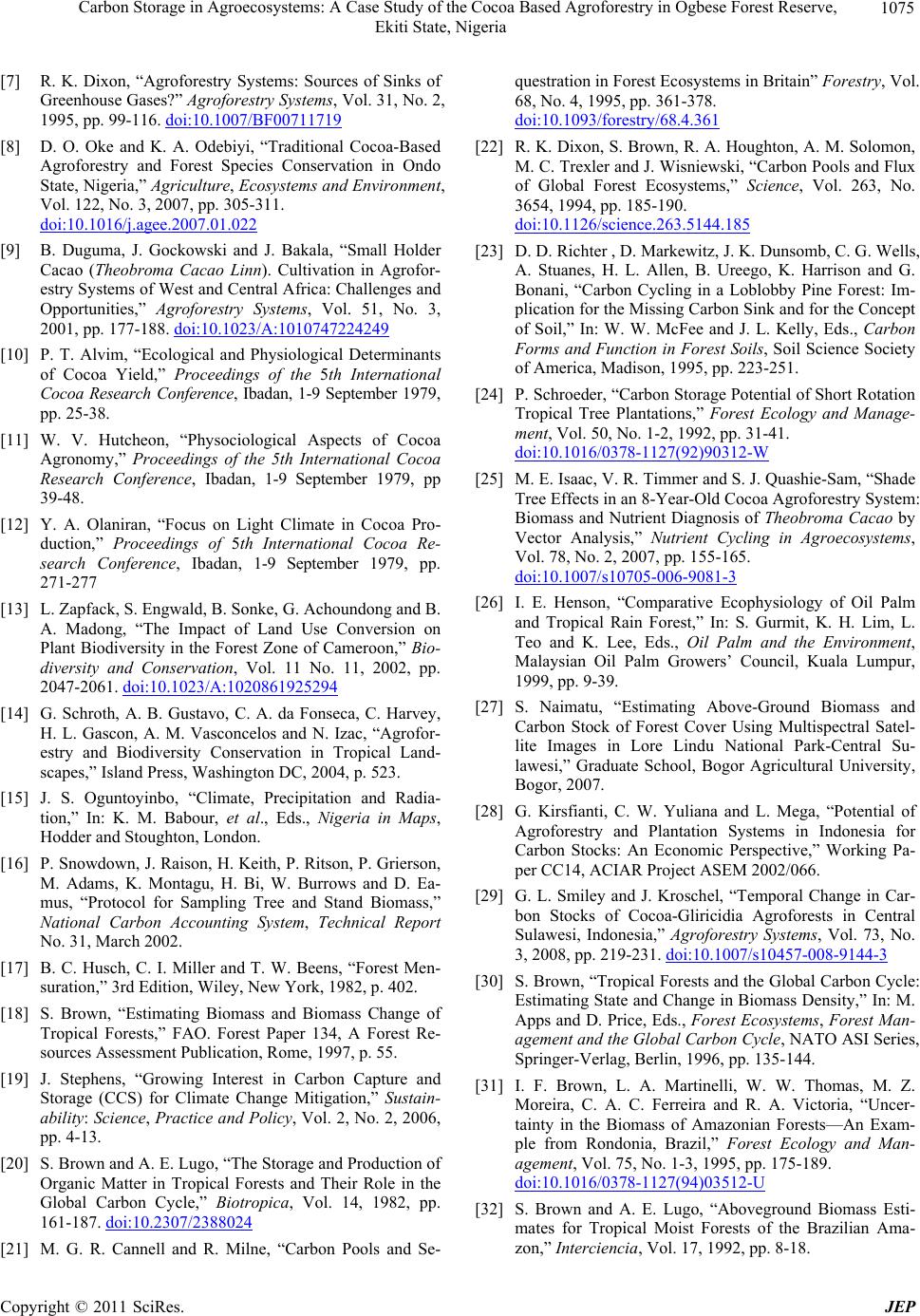
Carbon Storage in Agroecosystems: A Case Study of the Cocoa Based Agroforestry in Ogbese Forest Reserve, 1075
Ekiti State, Nigeria
[7] R. K. Dixon, “Agroforestry Systems: Sources of Sinks of
Greenhouse Gases?” Agroforestry Systems, Vol. 31, No. 2,
1995, pp. 99-116. doi:10.1007/BF00711719
[8] D. O. Oke and K. A. Odebiyi, “Traditional Cocoa-Based
Agroforestry and Forest Species Conservation in Ondo
State, Nigeria,” Agriculture, Ecosystems and Environment,
Vol. 122, No. 3, 2007, pp. 305-311.
doi:10.1016/j.agee.2007.01.022
[9] B. Duguma, J. Gockowski and J. Bakala, “Small Holder
Cacao (Theobroma Cacao Linn). Cultivation in Agrofor-
estry Systems of West and Central Africa: Challenges and
Opportunities,” Agroforestry Systems, Vol. 51, No. 3,
2001, pp. 177-188. doi:10.1023/A:1010747224249
[10] P. T. Alvim, “Ecological and Physiological Determinants
of Cocoa Yield,” Proceedings of the 5th International
Cocoa Research Conference, Ibadan, 1-9 September 1979,
pp. 25-38.
[11] W. V. Hutcheon, “Physociological Aspects of Cocoa
Agronomy,” Proceedings of the 5th International Cocoa
Research Conference, Ibadan, 1-9 September 1979, pp
39-48.
[12] Y. A. Olaniran, “Focus on Light Climate in Cocoa Pro-
duction,” Proceedings of 5th International Cocoa Re-
search Conference, Ibadan, 1-9 September 1979, pp.
271-277
[13] L. Zapfack, S. Engwald, B. Sonke, G. Achoundong and B.
A. Madong, “The Impact of Land Use Conversion on
Plant Biodiversity in the Forest Zone of Cameroon,” Bio-
diversity and Conservation, Vol. 11 No. 11, 2002, pp.
2047-2061. doi:10.1023/A:1020861925294
[14] G. Schroth, A. B. Gustavo, C. A. da Fonseca, C. Harvey,
H. L. Gascon, A. M. Vasconcelos and N. Izac, “Agrofor-
estry and Biodiversity Conservation in Tropical Land-
scapes,” Island Press, Washington DC, 2004, p. 523.
[15] J. S. Oguntoyinbo, “Climate, Precipitation and Radia-
tion,” In: K. M. Babour, et al., Eds., Nigeria in Maps,
Hodder and Stoughton, London.
[16] P. Snowdown, J. Raison, H. Keith, P. Ritson, P. Grierson,
M. Adams, K. Montagu, H. Bi, W. Burrows and D. Ea-
mus, “Protocol for Sampling Tree and Stand Biomass,”
National Carbon Accounting System, Technical Report
No. 31, March 2002.
[17] B. C. Husch, C. I. Miller and T. W. Beens, “Forest Men-
suration,” 3rd Edition, Wiley, New York, 1982, p. 402.
[18] S. Brown, “Estimating Biomass and Biomass Change of
Tropical Forests,” FAO. Forest Paper 134, A Forest Re-
sources Assessment Publication, Rome, 1997, p. 55.
[19] J. Stephens, “Growing Interest in Carbon Capture and
Storage (CCS) for Climate Change Mitigation,” Sustain-
ability: Science , Practice and Policy, Vol. 2, No. 2, 2006,
pp. 4-13.
[20] S. Brown and A. E. Lugo, “The Storage and Production of
Organic Matter in Tropical Forests and Their Role in the
Global Carbon Cycle,” Biotropica, Vol. 14, 1982, pp.
161-187. doi:10.2307/2388024
[21] M. G. R. Cannell and R. Milne, “Carbon Pools and Se-
questration in Forest Ecosystems in Brita i n” Forestry, Vol.
68, No. 4, 1995, pp. 361-378.
doi:10.1093/forestry/68.4.361
[22] R. K. Dixon, S. Brown, R. A. Houghton, A. M. Solomon,
M. C. Trexler and J. Wisniewski, “Carbon Pools and Flux
of Global Forest Ecosystems,” Science, Vol. 263, No.
3654, 1994, pp. 185-190.
doi:10.1126/science.263.5144.185
[23] D. D. Richter , D. Markewitz, J. K. Dunsomb, C. G. Wells,
A. Stuanes, H. L. Allen, B. Ureego, K. Harrison and G.
Bonani, “Carbon Cycling in a Loblobby Pine Forest: Im-
plication for the Missing Carbon Sink and for the Concept
of Soil,” In: W. W. McFee and J. L. Kelly, Eds., Carbon
Forms and Function in Forest Soils, Soil Science Society
of America, Madison, 1995, pp. 223-251.
[24] P. Schroeder, “Carbon Storage Potential of Short Rotation
Tropical Tree Plantations,” Forest Ecology and Manage-
ment, Vol. 50, No. 1-2, 1992, pp. 31-41.
doi:10.1016/0378-1127(92)90312-W
[25] M. E. Isaac, V. R. Timmer and S. J. Quashie-Sam, “Shade
Tree Effects in an 8-Year-Old Cocoa Agroforestry System:
Biomass and Nutrient Diagnosis of Theobroma Cacao by
Vector Analysis,” Nutrient Cycling in Agroecosystems,
Vol. 78, No. 2, 2007, pp. 155-165.
doi:10.1007/s10705-006-9081-3
[26] I. E. Henson, “Comparative Ecophysiology of Oil Palm
and Tropical Rain Forest,” In: S. Gurmit, K. H. Lim, L.
Teo and K. Lee, Eds., Oil Palm and the Environment,
Malaysian Oil Palm Growers’ Council, Kuala Lumpur,
1999, pp. 9-39.
[27] S. Naimatu, “Estimating Above-Ground Biomass and
Carbon Stock of Forest Cover Using Multispectral Satel-
lite Images in Lore Lindu National Park-Central Su-
lawesi,” Graduate School, Bogor Agricultural University,
Bogor, 2007.
[28] G. Kirsfianti, C. W. Yuliana and L. Mega, “Potential of
Agroforestry and Plantation Systems in Indonesia for
Carbon Stocks: An Economic Perspective,” Working Pa-
per CC14, ACIAR Project ASEM 2002/066.
[29] G. L. Smiley and J. Kroschel, “Temporal Change in Car-
bon Stocks of Cocoa-Gliricidia Agroforests in Central
Sulawesi, Indonesia,” Agroforestry Systems, Vol. 73, No.
3, 2008, pp. 219-231. doi:10.1007/s10457-008-9144-3
[30] S. Brown, “Tropical Forests and the Global Carbon Cycle:
Estimating State and Change in Biomass Density,” In: M.
Apps and D. Price, Eds., Forest Ecosystems, Forest Man-
agement and the Global Carbon Cycle, NATO ASI Series,
Springer-Verlag, Berlin, 1996, pp. 135-144.
[31] I. F. Brown, L. A. Martinelli, W. W. Thomas, M. Z.
Moreira, C. A. C. Ferreira and R. A. Victoria, “Uncer-
tainty in the Biomass of Amazonian Forests—An Exam-
ple from Rondonia, Brazil,” Forest Ecology and Man-
agement, Vol. 75, No. 1-3, 1995, pp. 175-189.
doi:10.1016/0378-1127(94)03512-U
[32] S. Brown and A. E. Lugo, “Aboveground Biomass Esti-
mates for Tropical Moist Forests of the Brazilian Ama-
zon,” Interciencia, Vol. 17, 1992, pp. 8-18.
Copyright © 2011 SciRes. JEP